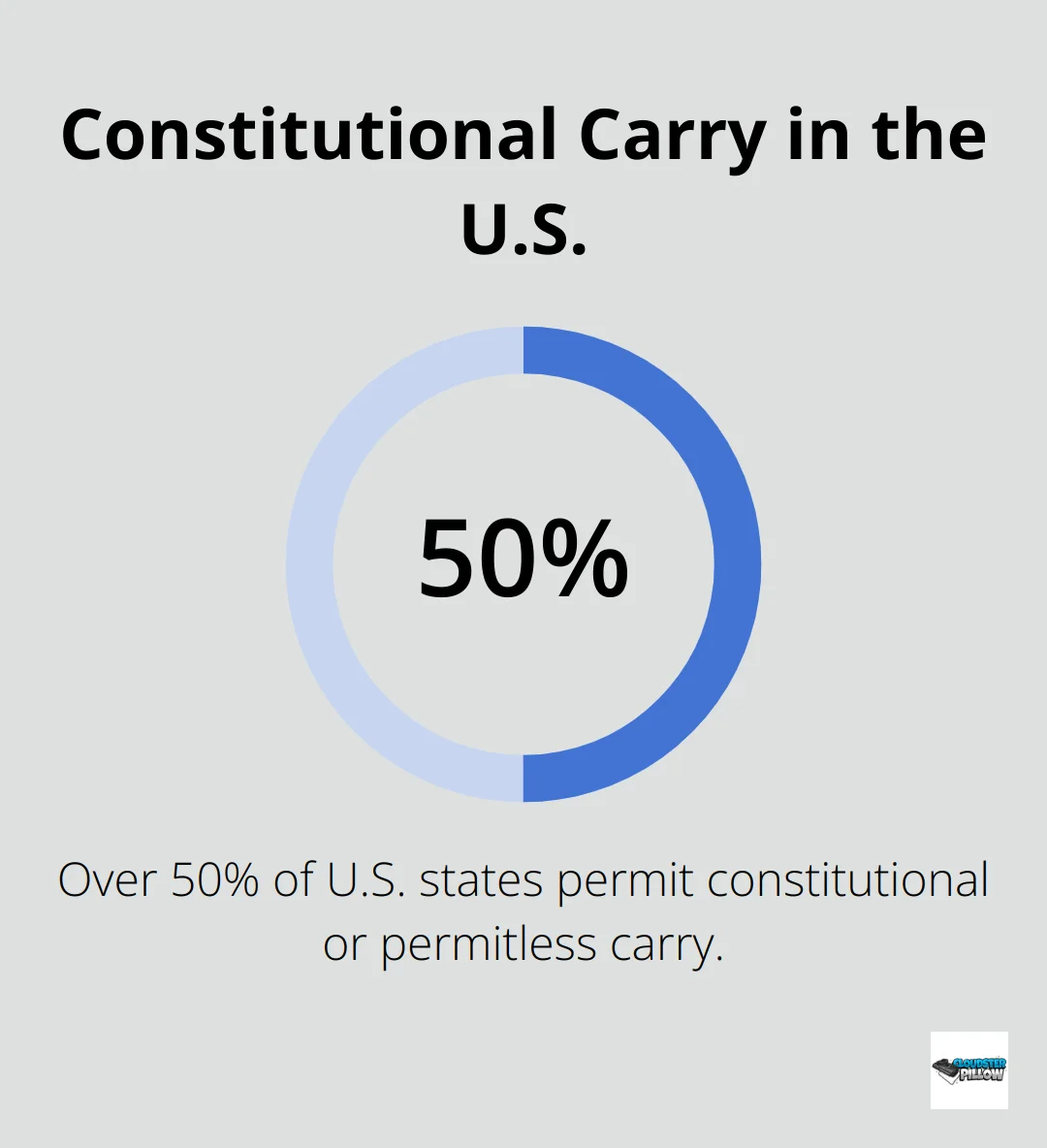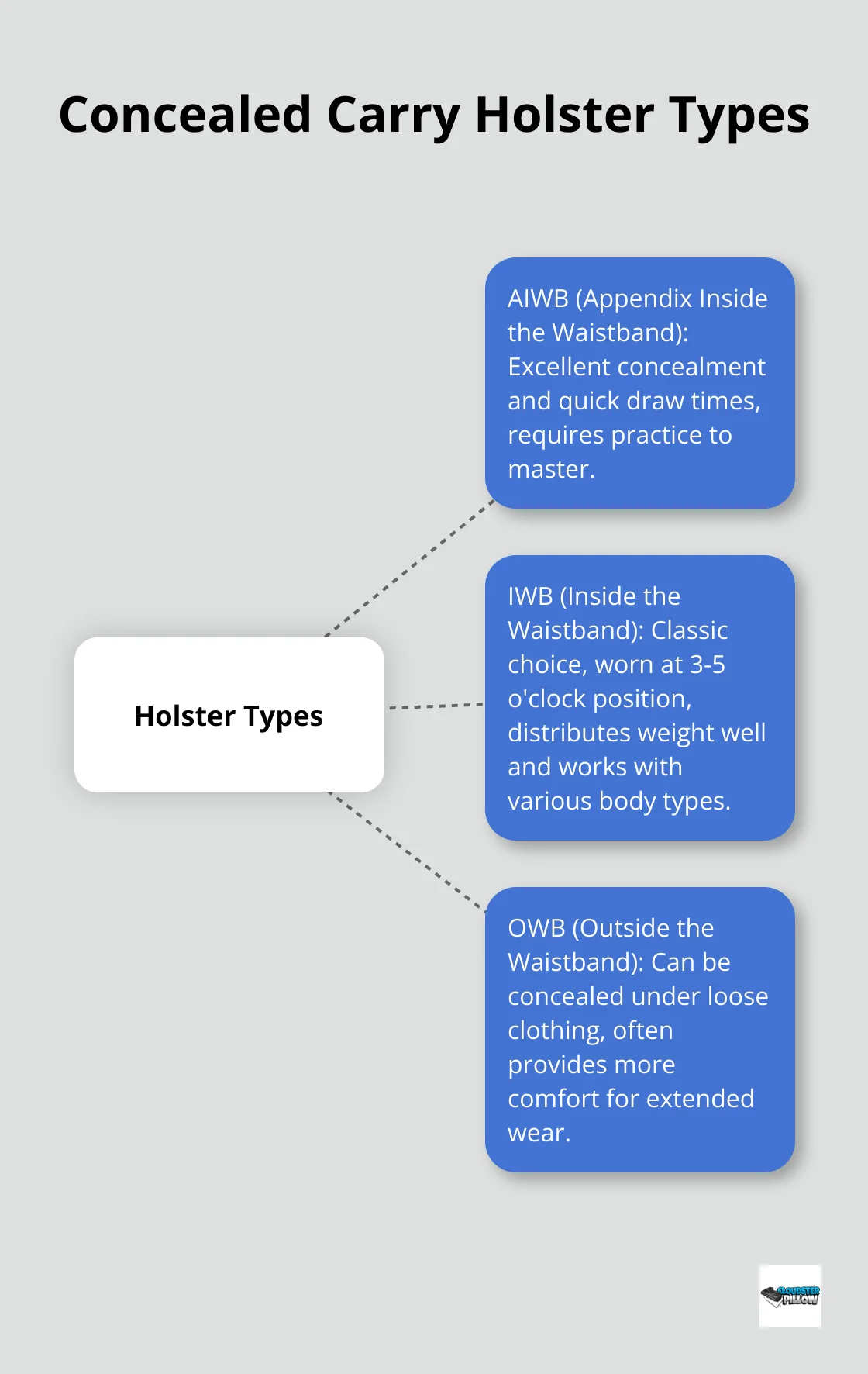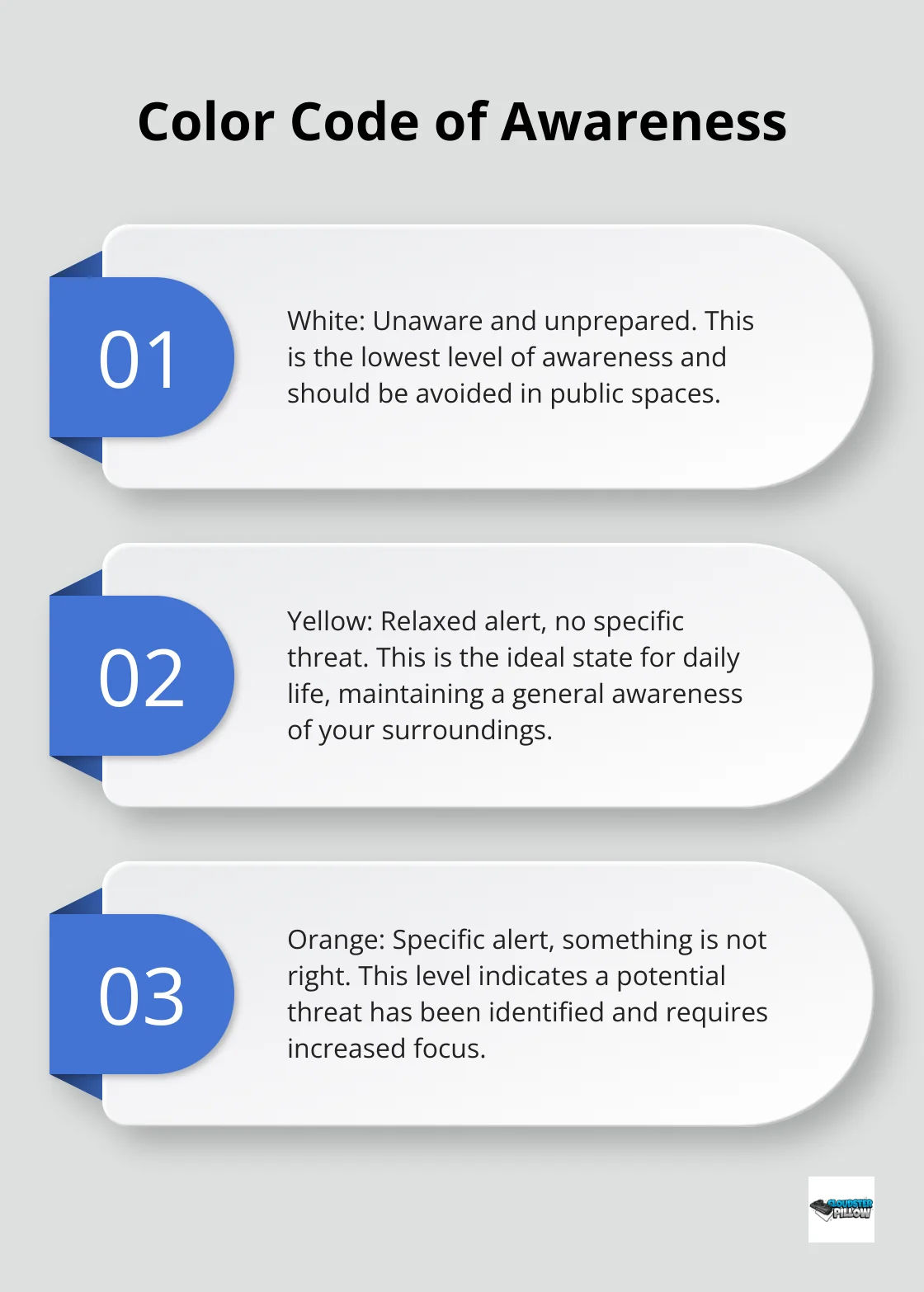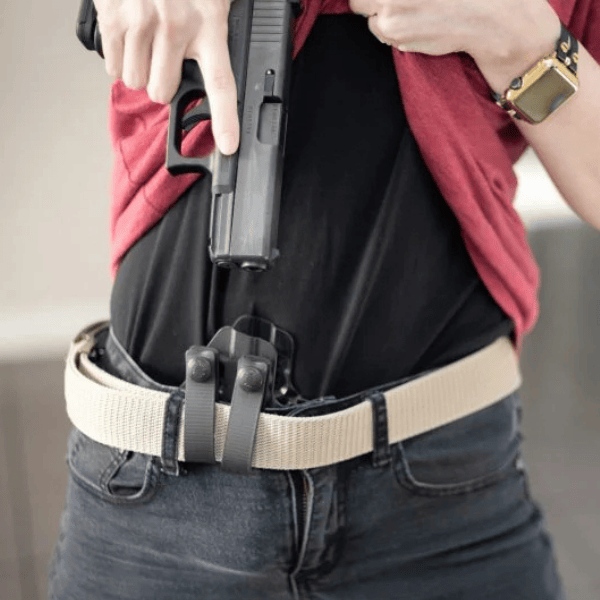Carry Techniques and Optimization, CCW Courses and Tips
The Ultimate Guide to Concealed Carry [2025]
Concealed carry is a responsibility that demands knowledge, skill, and dedication. At Cloudster Pillow, we understand the importance of staying informed about the latest laws, gear, and techniques in this ever-evolving field.
Our comprehensive guide will equip you with essential information to navigate the complex world of concealed carry in 2025. From understanding legal requirements to mastering practical skills, we’ve got you covered.
Navigating the Concealed Carry Legal Landscape
State-Specific Regulations
Concealed carry laws differ across the United States, which requires responsible gun owners to stay informed about the latest regulations. Over 50 percent of the U.S. has passed laws permitting constitutional or permitless carry. However, this doesn’t mean you can ignore state-specific rules.

Each state has its own set of regulations for concealed carry. For example, California has a specific process for obtaining a CCW, which demands dedication and patience. The application process includes fingerprint submission, a background check, and a fee. Check your local authorities for specific requirements and procedures.
Federal Laws and Interstate Travel
While states primarily govern concealed carry, federal laws also impact this right. The Law Enforcement Officers Safety Act (LEOSA) allows qualified current and retired law enforcement officers to carry concealed firearms nationwide. For civilians, the Firearm Owners Protection Act safeguards your right to transport firearms across state lines (provided the weapon is unloaded and locked in a container not readily accessible).
Reciprocity Agreements
Reciprocity agreements between states allow concealed carry permit holders to legally carry in participating states. The U.S. Concealed Carry Association (USCCA) offers a comprehensive Reciprocity Map to check which states honor your permit. Always verify this information before traveling, as agreements can change.
National Parks and Wildlife Refuges
National Parks and Wildlife Refuges have specific gun carry rules. Research these regulations if you plan to carry while visiting these areas. The rules may differ from state laws, so it’s essential to understand the specific requirements for each location.
Staying Informed and Prepared
Knowledge empowers concealed carriers. Stay up-to-date on your local laws, federal regulations, and reciprocity agreements to ensure you always comply with the law. Responsible gun ownership involves more than just having the right gear – it requires a thorough understanding and respect for the legal framework that governs our right to bear arms.
As we move forward, let’s explore how to choose the right concealed carry setup that complements your understanding of the legal landscape.
What’s the Best Concealed Carry Setup?
Selecting the right concealed carry setup impacts comfort, safety, and effectiveness. We’ll explore the key components to create an ideal combination for your needs.
Choosing Your CCW Firearm
Size plays a significant role when selecting a suitable firearm for concealed carry. Compact and subcompact models offer a balance of concealability and shootability. Popular choices include:
- Sig Sauer P365
- Glock 43X
- Smith & Wesson M&P Shield Plus
These firearms typically offer a capacity of 10-15 rounds (ample for most self-defense situations).
Your hand size and shooting proficiency should influence your choice. The Ruger LCP II .380 ACP is ultra-compact and easy to conceal but may challenge some users to shoot accurately. The Glock 19, while slightly larger, provides better control and capacity.
Holster Selection: AIWB, IWB, or OWB?
Your holster choice can significantly affect your concealed carry experience. Options include:

- Appendix Inside the Waistband (AIWB) holsters: Offer excellent concealment and quick draw times but require practice to master. Many AIWB holsters are tuckable, allowing you to tuck your shirt between the holster and belt clip for enhanced concealment.
- Inside the Waistband (IWB) holsters: A classic choice, worn at the 3-5 o’clock position. They distribute weight well and work with various body types.
- Outside the Waistband (OWB) holsters: Can be concealed under loose clothing and often provide more comfort for extended wear.
A quality holster should fully cover the trigger guard, retain the firearm securely, and allow for a full firing grip when drawing.
The Foundation: A Solid Gun Belt
A sturdy gun belt provides the necessary support to keep your firearm and holster in place throughout the day. Look for belts specifically designed for concealed carry. These belts are reinforced to prevent sagging and offer micro-adjustability for a perfect fit.
A quality gun belt improves comfort, enhances draw speed, and overall concealment. Don’t underestimate this often-overlooked component.
Enhancing Comfort and Concealment
To optimize your setup, consider accessories like the Cloudster Pillow holster wedge. Its design allows for a more natural and consistent draw motion, potentially saving crucial seconds when they matter most. The removable, washable cover ensures easy maintenance.
Other useful accessories include magazine carriers for spare ammo and purpose-built clothing that looks normal while accommodating your gear.
Regular maintenance ensures reliability when it matters most. Invest in a good cleaning kit and practice with your setup regularly.
Creating the perfect concealed carry setup requires experimentation and personal preference. What works for one person may not work for another. Try different combinations, seek advice from experienced carriers, and train regularly with your chosen setup. The right gear and mindset will equip you to carry responsibly and confidently.
As we move forward, let’s explore the techniques that will help you master your concealed carry setup and enhance your overall preparedness.
How to Master Concealed Carry Skills
Perfect Your Draw Stroke
A smooth, efficient draw can make all the difference in a self-defense situation. Start to practice your draw stroke at home with an unloaded firearm. Focus on consistency and gradually increase your speed as you become more comfortable.
Many experienced carriers recommend the “four-count draw” method:
- Establish a firm grip on the firearm while it’s still holstered.
- Clear the cover garment and draw the firearm to your chest.
- Rotate the muzzle toward the target and join your support hand.
- Extend your arms and acquire your sight picture.
Practice this sequence slowly and deliberately until it becomes second nature. Then, incorporate movement and different starting positions to simulate real-world scenarios.
Enhance Situational Awareness
Situational awareness serves as your first line of defense. Develop the habit to constantly scan your environment for potential threats or unusual behavior. The Color Code of Awareness, developed by Jeff Cooper, provides a useful framework:

- White: Unaware and unprepared
- Yellow: Relaxed alert, no specific threat
- Orange: Specific alert, something is not right
- Red: Condition red, fight is imminent
Try to maintain a constant state of yellow awareness in your daily life. This mindset allows you to enjoy your surroundings while remaining prepared to respond to potential threats.
Implement Effective Training Routines
Regular practice improves your skills. Dry fire practice at home refines your technique without the cost of ammunition. Invest in a quality dry fire training system to add realism and feedback to your practice sessions.
When you hit the range, focus on drills that simulate real-world scenarios. We recommend incorporating the following into your training routine:
- The Bill Drill: Six shots from concealment at 7 yards, focusing on speed and accuracy.
- Failure to Stop Drill: Two shots to the body, one to the head, emphasizing target transitions.
- El Presidente: Engaging multiple targets with reloads, testing your ability to manage complex scenarios.
Quality trumps quantity. It’s better to perform 50 deliberate, focused repetitions than 500 sloppy ones.
Dress for Concealment
Your clothing choices play a key role in effective concealment. Opt for loose-fitting garments that don’t print or reveal your firearm. Dark, patterned shirts can help break up any subtle bulges or lines.
Consider investing in purpose-built concealed carry clothing. These garments accommodate your firearm while maintaining a natural appearance. Many feature reinforced belt loops, stretchable fabrics, and strategically placed pockets (for enhanced concealment and accessibility).
Continuous Improvement
Mastering concealed carry requires ongoing effort. Focus on these key areas and commit to regular practice. You’ll develop the skills and confidence needed to carry responsibly and effectively. The goal is not just to carry a firearm, but to prepare to use it safely and effectively if the need ever arises.
FAQs
What are the legal requirements for concealed carry in different states?
Concealed carry laws vary by state. While some states allow constitutional or permitless carry, others require specific licenses, background checks, fingerprinting, and training. It’s essential to research your state’s laws before applying for a concealed carry permit.
How do reciprocity agreements affect my ability to carry concealed in other states?
Reciprocity agreements allow concealed carry permit holders to carry firearms in states that recognize their permit. It’s important to check which states honor your permit, as these agreements may change over time.
What are the best types of holsters for concealed carry?
The most common holsters are Appendix Inside the Waistband (AIWB), Inside the Waistband (IWB), and Outside the Waistband (OWB). The choice of holster depends on your comfort, body type, and preference for accessibility and concealment.
How do I select the best concealed carry firearm for myself?
Choose a firearm based on size, capacity, and ease of use. Compact and subcompact models like the Sig Sauer P365 or Glock 43X are popular options. Consider your hand size and shooting proficiency when making your decision.
How can I improve my concealed carry skills and preparation?
Mastering concealed carry requires practice. Focus on perfecting your draw stroke, situational awareness, and regular training routines. Additionally, invest in appropriate clothing for concealment and accessories for comfort, such as a sturdy gun belt.
Final Thoughts
Concealed carry requires dedication, education, and practice. You must understand legal landscapes, select appropriate equipment, and master essential skills. The Cloudster Pillow holster wedge enhances comfort and concealment for inside-the-waistband and appendix carry methods.
Proficiency in drawing, situational awareness, and practical shooting techniques demands consistent training. Regular practice builds muscle memory and confidence needed for effective concealed carry. Your clothing choices play a vital role in maintaining discretion while facilitating easy access to your firearm.
Concealed carry cultivates a mindset of preparedness, responsibility, and continuous improvement. You must stay vigilant, keep learning, and always prioritize safety for yourself and those around you. Carry responsibly, stay safe, and continue to hone your skills as a prepared and conscientious firearms owner.


Pingback: Chest Holsters for Outdoor Adventures - Cloudster Pillow
Pingback: Concealed Carry Reciprocity Maps [2025] - Cloudster Pillow